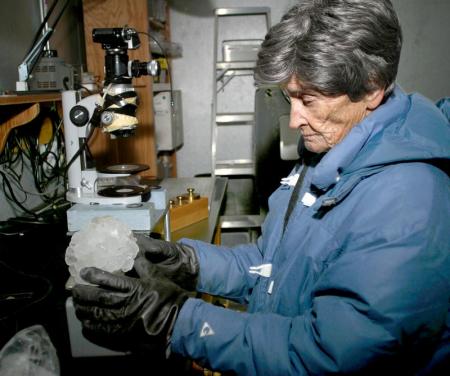Someone asked, “How can you assume that the speed of the raindrop is 8 meters per second?” That number comes from some resesarch we did a few years ago on a squall line (line of cumulonimbus) in the tropics. We were looking at a squall line with Doppler radar. This particular radar “saw” raindrops rather than clouds or air. So our Doppler radar could be used to estimate the raindrop fall speed. In the storm we were interested in, the raindrops in the heavy rain were falling at 8 meters per second. (Horizontally, the raindrops follow the wind pretty well — something you know if you are trying to stay dry in a windy rainstorm. This means that scientists can use Doppler radars to study winds in a storm.) These measurements have been used to check the equations scientists use to predict their speed — basically balancing air resistance with the pull of gravity.
The speed of the drop (or droplet) varies with its size. Very small drops, like those in clouds, fall so slowly that the tiniest breath of upward-moving air can keep them aloft. If you fly through a cumulus cloud, it’s bumpy — the air is moving up and down. So some droplets go up, and some go down. If they are tiny, the sinking droplets simply evaporate. So the cloud stays up there in the sky.
Scientists have also measured raindrop fall speeds with upward-looking radars that can “see” both the drops and air. This way they find out how fast the drops move downward relative to the air. So we know that drizzle drops fall at about 2 meters pers second, and raindrops smaller than ours would fall in between 2 meters per second and 8 meters per second.
Why are the speeds different? Drops fall because they are pulled downward by gravity. The drop speed varies with size because of air resistance. Air resistance slows the drops down. If there were no air, drops starting from the same height would fall together at the same speed. This speed would increase with time due to the pull of gravity. With air, the drops quickly reach a speed at which the pull of gravity is balanced by air resistance.
You can see this effect with a simple experiment. Take a piece of paper, and squeeze it into a ball. Take a tiny pice of paper (less than 1 cm), squeeze it into a ball. Drop them at the same time. See how long it takes the two pieces to fall to the ground. The tiny piece should fall more slowly. If you make the tiny piece even smaller, it will fall even more slowly.
What about snowflakes? They fall very slowly, like downy feathers do when you drop them. Using the paper again, you will find that the paper squeezed into a ball will fall faster than a similar size piece that is not squeezed into a ball.

Scientist holding large hailstone. Photograph courtesy of the National Center for Atmospheric Research.
What about big hailstones? If you guessed that they would fall faster, you are right. Large hailstones can fall at speeds faster than 30 meters per second! How do scientists know? Again, they can track hail with radar. Or, they can make fake hailstones that have the same shape and density as real hailstones, drop them, and measure the time it takes the stones to fall a certain distance. When I started working at the National Center for Atmospheric Research, one of the scientists was dropping fake hailstones down a five-story stairwell and timing their fall. The hailstones were painted so that the surface looked like a chessboard or checkerboard, so the cameras could see how they tumbled as they fell. This was fun to watch! Through the window, that is.
These measurements can then be used to check and refine the equations that describe falling objects.
